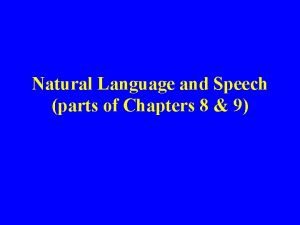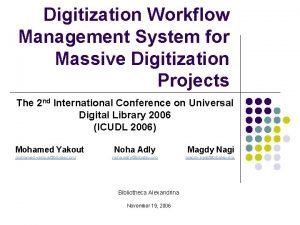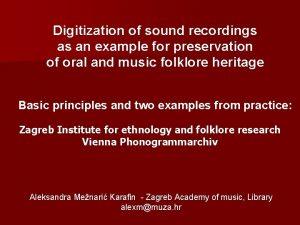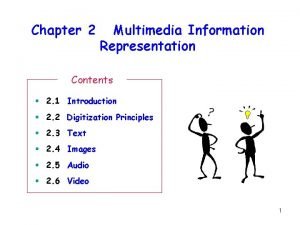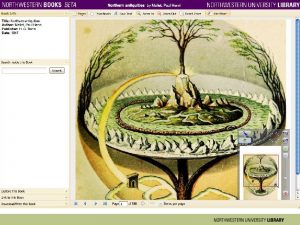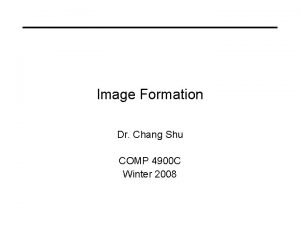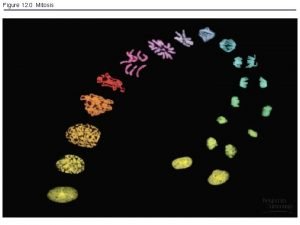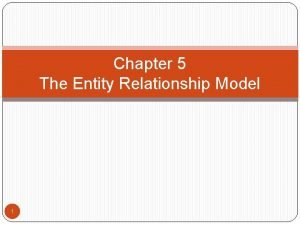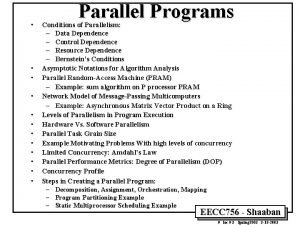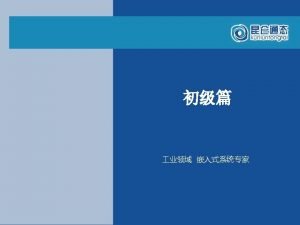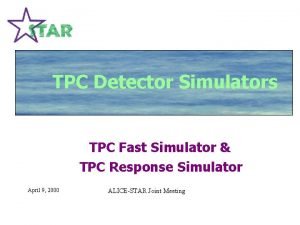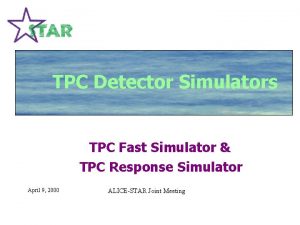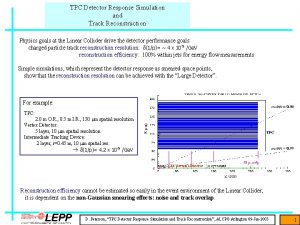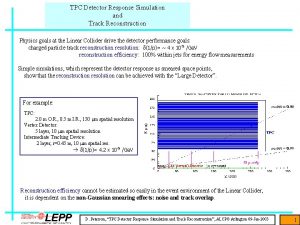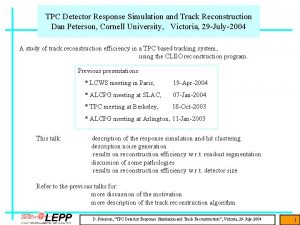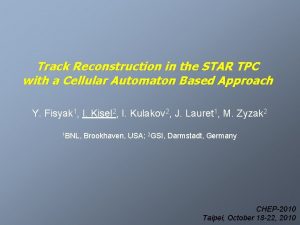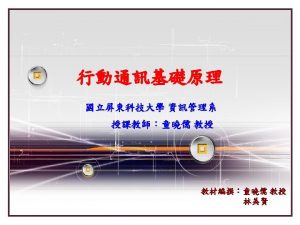TPC digitization and track reconstruction efficiency dependence on



















- Slides: 19

TPC digitization and track reconstruction: efficiency dependence on noise Daniel Peterson, Cornell University, DESY, May-2007 A study of track reconstruction efficiency in a TPC using simulation of the FADC response and the CLEO reconstruction program. This talk: description of the response simulation and hit clustering discussion on noise description noise generation small improvement to the reconstruction results on noise tolerance Refer to the previous talks for: more description of the track reconstruction algorithm (old) results on reconstruction efficiency w. r. t. readout segmentation (old) results on reconstruction efficiency w. r. t. detector size Previous presentations: * ECFA Vienna 16 -November-2005 * ALCPG Victoria 29 -July-2004 * LCWS Paris 19 -April-2004 Funded by the U. S. National Science Foundation (Cornell LEPP cooperative agreement). D. Peterson, “TPC Digitization and Reconstruction: Noise ”, LCWS 07, DESY, 30 -May-2007 1

Goals Goal: measure the reconstruction efficiency for complicated events simulating Linear Collider processes, w. r. t. design parameters of a TPC based tracking system: pad size, charge spreading, noise occupancy. A reconstruction of the simple “ionization centers”, 3 -dimentional space points chosen on the track trajectory is not sensitive to these parameters. Detector inefficiency due to track overlap, ionization (beam related) noise, and electronic noise can only be simulated a the level of the readout electronics, the FADC. Note: signals are simulated only to the extent necessary to measure the effects; signals are not generated from microscopic (atomic) effects. This is a continuation of an older implementation of the simulation (not Marlin). The Marlin implementation of the parameterized detector effects will be described in Jim Hunts talk in the simulation session. D. Peterson, “TPC Digitization and Reconstruction: Noise ”, LCWS 07, DESY, 30 -May-2007 2

notes on the reconstruction The reconstruction used here does not start with 3 -D space points. This study includes pattern recognition based on digitized pad-level signals. It requires simulation of the FADC output, pulse height and time response, as is necessary to provide sensitivity to hit overlap. The pattern recognition is a modification of the CLEO algorithm. The initial pass uses coarse information – local pulse height maxima satisfying loose z constraints. Precision information is derived from z and transverse clustering for hits satisfying the loose initial pass. In the previous presentations, I have concentrated on track recognition that does not requires optimized resolution. In this presentation, I will try to describe the degradation of the resolution due to hit occupancy. The resolution at low noise does not represent the ultimate resolution of a TPC because the transverse cluster finding is not optimized. Long-range contributions to the clusters are truncated. However, the resolution degradation at high occupancy becomes apparent. D. Peterson, “TPC Digitization and Reconstruction: Noise ”, LCWS 07, DESY, 30 -May-2007 3

Which TPC ? This study uses a TPC with 1. 9 meter outer radius and 3 Tesla field. (This is the old “North America Large Detector”) LDC Concept TPC outer radius: 1. 6 m magnetic field: 4 T cell size: 2 mm x 6 mm It is closer to the GLD concept TPC outer radius: 1. 8 m ? magnetic field: 3 T However, results on readout segmentation and noise tolerance should apply to a different design with similar track curvature separation. Compare BR 2. (this study) 10. 8 LDC 10. 2 GLD 9. 7 ? D. Peterson, “TPC Digitization and Reconstruction: Noise ”, LCWS 07, DESY, 30 -May-2007 4

Detector Simulation: pad response A simple simulation provides only crossing points; This study uses extensions to the simulation to achieve the goals. Geometry: 144 crossing points are treated as entries & exits for 143 layers. The 143 layers are segmented into pads. Note: treatment is not necessary with the equally spaced ionization centers in Mokka. Create ionization using the entry and exit positions for the cell. Ionization center is positioned on the average track position in each cell. Pulse height is distributed to neighboring cells using a pad response function. Gaussian width (70% of pad), cut-off (~. 002 of min. ion. ), charge is renormalized to provide a total of min. ion. Cells typically have contributions from several ionization centers. Create a time response for each contribution to pulse height based the Z projection of the track and the amplifier decay time. D. Peterson, “TPC Digitization and Reconstruction: Noise ”, LCWS 07, DESY, 30 -May-2007 5

Pulse height contributions on the pads Cell width: 4 mm Active cone: Z=[ r * (-3 / 40) ] +/- 4. 7 cm Thus, the simple layer crossings are converted to pulse height contributions on each pad. Diagnostic information can be displayed for the pads including: the index, pulse height, and time information contribution. D. Peterson, “TPC Digitization and Reconstruction: Noise ”, LCWS 07, DESY, 30 -May-2007 6

Detector Response: merging overlapping hits and time pattern recognition Pads may include overlapping signals that would be merged in the hardware readout. Each signal, including noise hits, is described by a pulse height, time, and duration at max. pulse height. This information is used to simulate a FADC response in which overlapping signals add. The FADC response is analyzed to determine the unambiguous threshold crossings ( ). The example shows merged hits and separated hits. (Also, note low level noise. ) Threshold crossings found in this procedure replace the original pad signals. D. Peterson, “TPC Digitization and Reconstruction: Noise ”, LCWS 07, DESY, 30 -May-2007 7

The beginning of event reconstruction: pad clustering Previous slides have described how the generated track crossing with ideal concentric cylinders are converted to FADC signals. The FADC signals were then processed to recognize “unambiguous” threshold crossings – single pad hits. Now these single pad hits are clustered in f to locate the significant centers of ionization that can be used by the pattern recognition. Pads with > 0. 51 of the maximum are treated as “core pads”. (a detail of the primary pattern recognition) Clustering in r-f A local maximum, above a threshold, defines a central pad. Adjacent pads, above a lesser threshold are added to the cluster. Difference in Z of adjacent pads is required to be less than a threshold. Clusters are Split at local minima, less than a fraction of the lesser peak. Splitting of overlapping clusters is not precise. A pad, which may have contributions from 2 (or more) sources, is assigned to the larger neighbor as shown. This may lead to non-gaussian smearing of the central position. In addition, the cut-off for adding low-level charge to the cluster degrades the resolution. D. Peterson, “TPC Digitization and Reconstruction: Noise ”, LCWS 07, DESY, 30 -May-2007 8

Projected hits for event, after detector response simulation and clustering PH and time information Active cone: Z=[ r * (-7 / 40) ] +/- 4. 7 cm Active hits in green cluster information Ignored hits in purple This is the information input to the pattern recognition. The pad response includes merged hits with time and pulse height information. Simple, pre-merged, hits have been “hidden” ( or eliminated). Clustering has been completed for the initial pattern recognition. D. Peterson, “TPC Digitization and Reconstruction: Noise ”, LCWS 07, DESY, 30 -May-2007 9

MC tracks are selected for efficiency studies; the denominator Not Used Plausible tracks recognized in the hit list MC generated track list 1) curv 1, f 1, impact 1, Z 01, COS(q)1 2) curv 2, f 2, impact 2, Z 02, COS(q)2 3) curv 3, f 3, impact 3, Z 03, COS(q)3 … … N) curv. N, f. N, impact. N, Z 0 N, COS(q)N MC generated hit list 1) gen. track 1, layer 1, X 1, Y 1, Z 1 2) gen. track 1, layer 2, X 2, Y 2, Z 2 3) gen. track 1, layer 3, X 3, Y 3, Z 3 … Sub-list of contiguous generated hits satisfying… a) same generated track number b) starts at layer 1 c) increasing layer number d) truncated if layer number decreases (top of curler) e) continues through at least 30 layers … M) gen. track. M, layer. M, XM, YM, ZM TRACK FIT i) gen. tracki, layer 1, Xi, Yi, Zi … j) gen. tracki, layern, Xj, Yj, Zj “Plausible Track” List 1) curv 1, f 1, COT(q) 1, … n) curvn, fn, COT(q) n, impact 1, Z 01 impactn, Z 0 n Match c 2 = (DC/. 002)2+(Df/. 003)2+(DCOT/. 002)2 D. Peterson, “TPC Digitization and Reconstruction: Noise ”, LCWS 07, DESY, 30 -May-2007 10

Track finding efficiency dependence on pad width and track “curvature”. Require c < 25 (defined on previous slide. ) This is the result shown at Victoria, 2004. Within error, the efficiency for MED/HIGH curvature tracks is ~ 94% and largely independent of pad size; these tracks are spread outside the jets. The efficiency for LOW curvature tracks is >99% for pad size <4 mm. Based on this information, there is little improvement for a pad size below 3 mm (an angular coverage in the outer layer of 0. 0016). Resolution, rather than efficiency, considerations should determine the pad size for the TPC. D. Peterson, “TPC Digitization and Reconstruction: Noise ”, LCWS 07, DESY, 30 -May-2007 11

Efficiency dependency on Noise: voxel occupancy and distorted hits In the previous slide, the voxel occupancy is 1%. But a track measurement signal in one layer occupies many more that 1 voxel; the probability of a noise hit distorting the signal is more than the occupancy. The signal is spread in Z. Noise signals within ( ± 1 characteristic signal length ) will affect the signal. (factor of 2) For data hits, longitudinal spread depends on the longitudinal angle, decay time = 2 cm For noise hits, define longitudinal spread = 2 cm , decay time =2 cm, total=4 cm The signal is spread in f. Noise signals in the central cell and in ( ± 1 cell ) will affect the signal. (factor of 3) The probability of distorting a track measurement signal is 2 * 3 * (occupancy for voxels of characteristic signal length (4 cm) ) D. Peterson, “TPC Digitization and Reconstruction: Noise ”, LCWS 07, DESY, 30 -May-2007 12

Efficiency dependency on Noise 0 noise hits 3 mm cells Active cone: Z=[ r * (-4 / 40) ] +/- 4. 7 cm 4. 8 % occupancy For 3 mm cells, efficiency will be determined for occupancy up to 4. 8% ( ~29% of hits distorted ). (3. 6% was shown at Vienna, 2005. ) The amplitude of the noise signals is in a range; 0: 2 x min-ionizing; ave=1 min-ionizing. D. Peterson, “TPC Digitization and Reconstruction: Noise ”, LCWS 07, DESY, 30 -May-2007 13

Reconstruction Improvement While attempting to improve the reconstruction efficiency for high occupancy, discovered a pathology in the time pattern recognition that affected even zero noise, was discovered. The pathology was due to the way that new time pulses can be recognized when another time pulse is still “active” and resulted in large residuals. This was addressed by requiring that new time pulses can not be initiated within 2 x an applied smoothing width after the initialization of a previous time pulse. The rate of large residuals was reduced and the efficiency was improved. The details of clustering in both time and f can greatly affect the resolution. D. Peterson, “TPC Digitization and Reconstruction: Noise ”, LCWS 07, DESY, 30 -May-2007 14

Efficiency dependency on Noise This is an extension of the results shown at Vienna, 2005. For 4. 8% occupancy 2. 4 x 106 noise hits ( 29 % of hits affected by noise ) the efficiency decreases by 6%. In this case, “noise hits” are single-pad, not spread by pad-response-function. However, “noise hits” have the full time distribution. The result is for a particular pattern recognition package. Another pattern recognition package may do better. D. Peterson, “TPC Digitization and Reconstruction: Noise ”, LCWS 07, DESY, 30 -May-2007 15

Hit efficiency and track fit quality dependency on Noise In the next slide, I will show the efficiency w. r. t. the curvature matching resolution for various occupancy. This resolution is dependent on the selection and removal of identified “bad hits”. Note: with increasing occupancy, c 2, and the number of hits removed, increase. There is a limit to the number of hits that can be removed. There anti-correlated fluctuations. Further investigation of the hit deletion could yield improvements in the resolution. D. Peterson, “TPC Digitization and Reconstruction: Noise ”, LCWS 07, DESY, 30 -May-2007 16

( Efficiency vs resolution ) dependency on Noise The efficiency at 10 mm cut-off in sagitta deviation is the result shown on slide 15. There is a loss in efficiency for a sagitta cut-off up to 1 mm, even for zero noise. This is possibly due to non-optimal f clustering and low pulse height truncation in both generation and clustering. The resolution with 1% occupancy is indistinguishable from zero noise. ( difference between the fitted track and a fit to the ionization centers ) D. Peterson, “TPC Digitization and Reconstruction: Noise ”, LCWS 07, DESY, 30 -May-2007 17

( Efficiency vs resolution ) dependency on Noise Plotted for 2 mm pad width. There is an overall improvement in the resolution. Note that 2% occupancy for 3 mm pads is displayed for comparison. ( difference between the fitted track and a fit to the ionization centers ) D. Peterson, “TPC Digitization and Reconstruction: Noise ”, LCWS 07, DESY, 30 -May-2007 18

Summary, Outlook DESY, May-2007 With 1% noise, 3 mm pads (1. 9 meter radius) will provide 99. 5% reconstruction efficiency for straight tracks, within |cos(q)| <0. 9. The sagitta resolution with 1% occupancy is not degraded relative to zero noise. 2% occupancy results in minor degradation of the sagitta resolution. 4. 8% occupancy results in 6% efficiency loss and significant resolution degradation. One should be careful with the clustering algorithms to optimize resolution. This is as far as we can go with this study. Jim Hunt is implementing the FADC simulation and reconstruction in Marlin. This will eventually provide (depending on the level of reconstruction) FADC pulse height spectrum for each pad, or pad hits with pulse height and time derived from the FADC simulation, or 3 -D space hits that include the effects of overlap. See Jim Hunts talk in the simulation/reconstruction session. D. Peterson, “TPC Digitization and Reconstruction: Noise ”, LCWS 07, DESY, 30 -May-2007 19
 Productive inefficiency and allocative inefficiency
Productive inefficiency and allocative inefficiency Allocative efficiency vs productive efficiency
Allocative efficiency vs productive efficiency Productively efficient vs allocatively efficient
Productively efficient vs allocatively efficient Speech digitization and generation in hci
Speech digitization and generation in hci Project management and workflow for digitization projects
Project management and workflow for digitization projects Image acquisition and digitization
Image acquisition and digitization What is a linear transformation linear algebra
What is a linear transformation linear algebra Voice digitization
Voice digitization Digitization of sound
Digitization of sound Global trade digitization
Global trade digitization Introduction to digitization
Introduction to digitization Cp 4k786
Cp 4k786 Sr digitalization
Sr digitalization Web based workflow software
Web based workflow software Digitization in indiana
Digitization in indiana Comp4900
Comp4900 Ddo template 4
Ddo template 4 Female karyotype
Female karyotype Erd identifier
Erd identifier Program data dependence is caused by
Program data dependence is caused by



